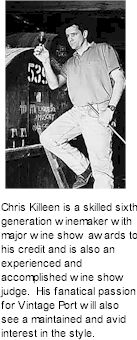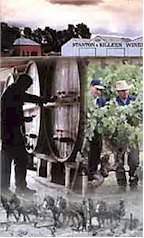

In 1864 together with his son John Lewis Stanton, Timothy purchased land at Rutherglen in North East Victoria immediately establishing a farm and vineyard. By 1875 the Stantons were well established as successful Rutherglen vignerons. Timothy's grandson John Richard Stanton continued to improve and expand the business and by the 1920s had established the magnificent Park View vineyard and winery.

The lineage continued until 1948 when Norman Killeen married Joan Stanton and in 1953 he joined her and his father-in-law in the formation of Stanton and Killeen Wines. Norman's son Chris took over as winemaker in 1981, thus becoming the sixth generation of Stanton and Killeen winemakers in the Rutherglen district.
The Stanton and Killeen property is situated three kilometres due west of Rutherglen on the Murray Valley Highway on gently undulating picturesque farming country. It is the wonderful origins of history that make this winemaking family so important to the pioneering story of Rutherglen and the development of winemaking in Australia.
Some of the original vineyards planted by Jack Stanton in 1921 are still in production and produce some of the finest fruit in the district. The most notable being the old shiraz vines which produce the now famous Jacks Block Shiraz dry red while also providing the blockbuster blending material for the equally famous Stanton and Killeen Vintage Port. Other grape varieties planted at Stanton and Killeen include Chardonnay, Durif, Cabernet Sauvignon, Cabernet Franc, Merlot, Muscat, Muscadelle and the port varieties of Touriga Nacional, Tinto Cao, Tinta Barroca and Tinta Roriz.

Over 300 hectares are devoted to mixed farming enterprises while 30 hectares of the best well drained soils are planted to vines with an annual production of approximately 250 tonnes. The soil ranges in quality from gravel ridges to red loam on the slopes under which lies a porous clay. It is on these latter soils that the classic muscat, tokay and full bodied dry reds are produced.
The Stanton & Killeen winemaking facilities utilise not only the modern technology of stainless steel and cool fermentation techniques but also the traditional method of open vat fermentation, thus maintaining over one hundred years and six generations of winemaking experience, skill and mystery into the production of supreme Rutherglen wine. The winery is open for daily wine sales and tastings every day except Good Friday and Christmas Day.
Stanton & Killeen is in a picturesque setting on gently undulating farmland with shaded parking and barbeque/picnic facilities. There is a comfortable fully air-conditioned cellar door tasting room where a full range of award winning table and dessert wines including distinctive full bodied dry reds, famous Rutherglen Muscats and Tokay Dessert Wines, Vintage Ports and White table wines are available for tasting and purchase.
























